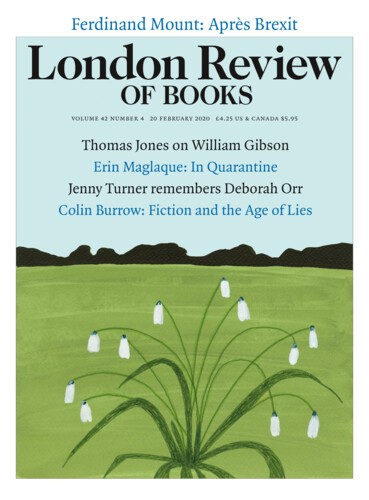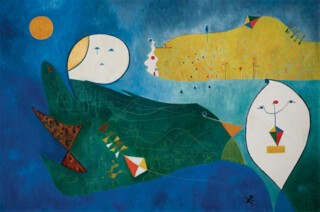Alice Paalen Rahon was a shape-shifter par excellence, who casually changed her date and place of birth (1904 in Besançon, not 1916 in Brittany), her name and nationality, sexual orientation and artistic genre. After publishing three volumes of poems in French as Alice Paalen, she divorced and took her mother’s maiden name, Rahon; by now living in Mexico, she turned almost entirely to painting. This doubleness is evident in every room of the exhibition of her work at the North Miami Museum of Contemporary Art (until 29 March).
In her twenties Alice Phillipot moved to Paris, where she designed hats with Elsa Schiaparelli and modelled for Man Ray. In 1931 she met the Austrian painter Wolfgang Paalen, whom she married in 1934. The pair became involved with the Surrealists and others orbiting their circle, including Picasso and Joan Miró, who, hearing of the Paalens’ interest in prehistoric art, suggested they visit the Altamira caves in Spain. There, they were entranced by the polychrome cave paintings, the influence of which can be seen in Rahon’s later work as a painter, with its brilliant colours, mythical invocations and symbolic markings.
Her first work, however, was as a poet, and her first collection, À même la terre, with a print by Yves Tanguy, appeared in 1936. That same year she had an affair with Picasso, leading Paalen to threaten suicide if she left him (her poem ‘Despair’ begins ‘the firework has gone off. Grey is the absolute colour of present time’). Soon afterwards, she travelled to India with the Surrealist Valentine Penrose, who was separated from her husband, Roland. The women spent two months together in an ashram at the foot of the Himalayas, and then Alice returned to Paalen. In 1938 her second collection of poems, Sablier couché, which could be translated as ‘Hourglass Lying Down’ or ‘Sleeping Hourglass’, came out. The book was described by André Breton as a ‘talisman’ on account of its confrontation of opposites: night and day, sleep and wakefulness, the passing of time and the immediate moment.
Early the next year Rahon met Frida Kahlo in Paris, and was invited to Mexico. She and her husband, along with the Swiss photographer Eva Sulzer, made their way south through Alaska and the totemic landscapes of the Pacific Coast, which would be evoked in the magical landscapes and apparitions Rahon painted in the following decades. The outbreak of the Second World War compelled the Paalens and Sulzer to settle in Mexico City. Lame all her life after breaking her right hip when she was three and her leg nine years later, Rahon became especially close to Kahlo, who shared her interest in folk art and was also disabled as the result of an accident.
There were many other émigré Surrealists in Mexico City, including Cesar Moro, Remedios Varo, Benjamin Péret, Leonora Carrington, Gordon Onslow-Ford and his wife, the writer Jacqueline Johnson, who became a close friend to whom Rahon dedicated a few poems. Her last collection, Noir Animal, appeared in 1941, although she did contribute some work to Dyn, the journal founded by Paalen, which appeared for two years during the war.
She began to paint soon after her arrival in Mexico, using various media (ink, gouache, crayons, and in her sculptural constructions, iron wire) and found objects, including leaves and butterfly wings, along with scatterings of gold dust or feathers, which were placed on different supports (silk, cardboard, Japanese paper). She painted stars, moons, suns and constellations, owls and cats, a great deal of water (she was a very strong swimmer), imaginary cities, together with depictions of legends, myths, heroic figures and feast days. Ritual and magic abound in her work: she scratched silhouettes on her paintings and sprinkled sand and volcanic ash on them. You can sense the inspiration of Paul Klee, especially his imaginary places, pictograms and symbols.
An early series of works, Crystals in Space (1943), brush paintings in white gouache on black paper, prefigure in their bright lines and dots the set of wire marionettes she made a few years later when planning a cosmic ballet about Orion, which imagines life after the planet’s destruction by a nuclear bomb. After ‘the night of the beginning’, the Juggler appears and creates the Androgyne – uniting the genders – then the bright female Betelgeuse, the Dog (the Egyptian god Anubis, mediating between earth and sky) and, finally, the Bird of Paradise, bringing light after the darkness. The wire marionettes are reminiscent of the work of Alexander Calder, another friend, who sometimes exhibited with her.
After divorcing Paalen in 1947, she married the Canadian Edward Fitzgerald, who had worked on Luis Buñuel’s sets, and with whom she made a film called ‘Le Magicien’, about life after a nuclear disaster (again). This time, the only survivor is a magician living in a cavern at the bottom of the sea, who attempts to recreate humankind by alchemy. Rahon designed the costumes, made more marionettes and wrote the screenplay. But, lacking the necessary backing, the film was never distributed and has been lost, except for a few stills. By the time it was finished, Rahon and Fitzgerald had divorced.
Several of Rahon’s works were tributes to her friends, including de Chirico – Celestial Shadow celebrates his combination of writing and painting – as well as Kahlo and Miró. The two blue watery swervings in Man Crossed by a River (Tribute to André Breton) (1967) nod to Breton’s identification of water as the feminine element, and make clear his lasting influence on her work, which continued to invoke the Surrealist ideal of the marvellous, what Louis Aragon called ‘the eruption of contradiction within the real’, the shock or frisson that Surrealist art was intended to produce. Rahon portrayed herself as a ‘femme-enfant’, an Alice in Wonderland, in Madame Dimanche (c.1955), with its kite-flying, scratched doodles and echoes of Miró.
In 1969, at the opening of an exhibition of her work, she fell down the stairs, fracturing her hip again. Refusing treatment, she lived in seclusion until her death in a nursing home in Mexico City in 1987. How alive she seems in this exhibition. It is marvellous in the usual sense of the word, as well as in the always extraordinary Surrealist sense.
Send Letters To:
The Editor
London Review of Books,
28 Little Russell Street
London, WC1A 2HN
letters@lrb.co.uk
Please include name, address, and a telephone number.


